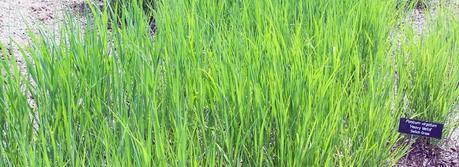
Panicum virgatum 'Heavy Metal' Switch Grass in early summer at Minnesota Landscape Arboretum (Credit: SEWilco, http://commons.wikimedia.org/wiki/User:SEWilco)
A new study by U.S. Department of Agriculture scientists provides an extensive analysis of costs and benefits of replacing home oil heating systems with switchgrass pellets powered ones. In a paper published in the Environmental Science & Technology, authors argue that switchgrass could potentially be a cheaper source of energy than oil.
Agricultural Research Service (ARS) researcher Paul Adler led efforts on a lifecycle analysis that compared costs of energy generation from coal, natural gas, fuel oil, and switchgrass in the form of energy-dense cubes, briquettes, and pellets. Adler works at the ARS Pasture Systems and Watershed Management Research Unit in University Park, Pa.
ARS is USDA’s chief intramural scientific research agency, and this work supports the USDA priority of finding new sources of bioenergy.
The researchers calculated the economic outlays associated with switchgrass production throughout the supply chain, as well as greenhouse gas emissions generated by switchgrass production, densification, and conversion to heat and power. This included the first lifecycle inventory of switchgrass seed production and greenhouse gas emissions associated with seed production.
The analysis indicated that 192 pounds of “carbon dioxide equivalent,” or CO2e, was emitted for every ton of switchgrass dry matter that was sown, harvested, and delivered to densification plants for processing into pellets. CO2e is a measurement used to compare the emissions from various greenhouse gases based upon their global warming potential.
The researchers calculated that using switchgrass pellets instead of petroleum fuel oil to generate one gigajoule of heat in residences would reduce greenhouse gas emissions by 146 pounds of CO2e. Totaling all costs associated with installing an appropriate residential heating system and fuel consumption, the team concluded that each gigajoule of heat produced using switchgrass pellets would cost $21.36. Using fuel oil to produce the same amount of heat would cost $28.22.
Adler is now working with Plainview Growers to determine how the carbon footprint differs between heating greenhouses with biomass and heating them with fuel oil. Plainview Growers, which has its headquarters in Pompton Plains, N.J., sells more than 160 million nursery plants produced from seeds every year.
By Ann Perry
Wilson, T., McNeal, F., Spatari, S., G. Abler, D., & Adler, P. (2012). Densified Biomass Can Cost-Effectively Mitigate Greenhouse Gas Emissions and Address Energy Security in Thermal Applications Environmental Science & Technology, 46 (2), 1270-1277 DOI: 10.1021/es202752b
